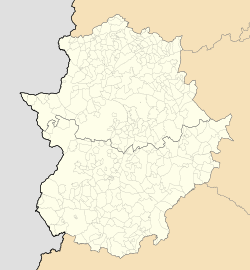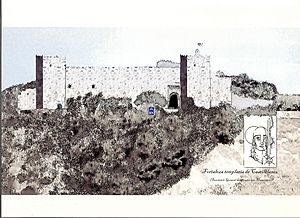Castilblanco facts for kids
Quick facts for kids
Castilblanco
|
|||
|---|---|---|---|
|
|||
| Country | |||
| Autonomous community | |||
| Province | Badajoz | ||
| Founded | 12th century | ||
| Government | |||
| • Type | Mayor–council | ||
| • Body | Ayuntamiento de Castilblanco | ||
| Area | |||
| • Total | 131,6 km2 (508 sq mi) | ||
| Elevation | 501 m (1,644 ft) | ||
| Population
(2018)
|
|||
| • Total | 972 | ||
| • Density | 0.7386/km2 (1.9130/sq mi) | ||
| Demonym(s) | castilblanqueño (m), castilblanqueña (f) | ||
| Time zone | UTC+1 (CET) | ||
| • Summer (DST) | UTC+2 (CEST) | ||
| Postal code |
06680
|
||
| Website | www.castilblanco.es | ||
Castilblanco is a small town, also called a municipality. It is located in the province of Badajoz, in the Extremadura region of Spain. In 2005, about 1,146 people lived there. It's a place with a rich history and interesting natural surroundings.
Contents
What's in a Name? The Story of Castilblanco
The name Castilblanco means "white castle." People believe it comes from an old castle that once stood where the San Cristóbal church is today. No one knows for sure who built this castle. It might have been built by Arabs or Christians around the 12th century. This was during a time called the Reconquista, when Christian kingdoms were taking back land in Spain.
Some historians think Castilblanco was a special place for the Knights Templar. These were famous medieval knights. They wore white robes. So, the town might have been called "white castle" or "castle of the whites" because of their clothing.
Symbols of Castilblanco
The official symbol of Castilblanco is its coat of arms. A coat of arms is like a special emblem for a town or family. This one tells a story about Castilblanco.
- The Castle: It reminds everyone of the town's origins and the old castle.
- The Oak and Olive Trees: These are the most common trees growing in the area around Castilblanco.
- The "Villa" Declaration: This part remembers when Castilblanco became an independent town in 1554. Before that, it was part of another area.
- The Rock-Rose Flower: This flower is a symbol of the La Jara region. Castilblanco used to be part of La Jara. Later, it joined the province of Badajoz.
The government of Extremadura officially approved this coat of arms in 1986. Its official description in Spanish is:
Escudo Cuartelado, trayendo: 1ª, de gules, un castillo árabe de plata. 2ª de plata, un olivo de sinople. 3ª, también de plata, una encina de sinople. 4ª, de azur, una cartela de plata con la leyenda "Declaración de Villa por Carlos I, año de 1554", en letras de sable. Sobre el todo una flor de jara. Al timbre, corona mural de villa.
Where is Castilblanco? Physical Geography
Location of the Town
Castilblanco is located in a region called La Siberia. This area borders other provinces like Cáceres, Ciudad Real, and Toledo. The town itself is built on a hill. This hill is south of the Guadalupe Range. This mountain range is part of the Toledo Mountains.
The town sits between two important rivers: the Guadiana and the Guadalupe. Castilblanco is also part of the judicial district of Herrera del Duque.
Mountains and Land Around Castilblanco
The town center of Castilblanco is on a hill. This hill rises above the flat land around it. To the north, there's a wide area with many narrow valleys. Streams flow through these valleys and empty into the Guadiana and Guadalupe rivers.
The eastern part of the municipality has very uneven land. The western and southern parts are mostly fields with gentle slopes.
Several mountain ranges surround Castilblanco. These ranges are part of the Toledo Mountains. The mountains to the north are the tallest. These include the Guadalupe Range, Altamira Range, and Villuercas Range. The Villuercas Range reaches about 1,600 meters high.
The land to the east is also hilly but not as high. Its highest points are around 700 meters. Here you can find ranges like Rinconada, Palomera, and Umbría. To the south, where the Guadiana and Guadalupe rivers meet, there are more mountains. These include Barbas de Oro, Pastillos, Chimenea, Escorial, Villares, and Golondrinos. These southern ranges are similar in height to those in the east.
A Glimpse into History
In April 1556, Castilblanco received an important title: Villa, which means "town." King Carlos I granted this title. He did it because the Archbishop of Toledo asked him to. At that time, about 296 families lived in Castilblanco. Before this, Castilblanco was considered just an extension of a nearby town called Talavera. Getting the Villa title meant Castilblanco became its own independent town.
See also
 In Spanish: Castilblanco para niños
In Spanish: Castilblanco para niños





